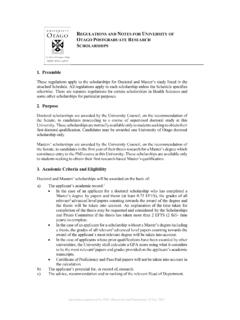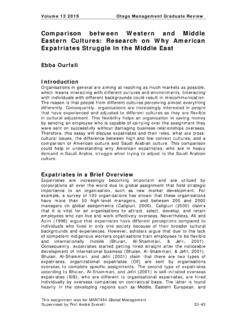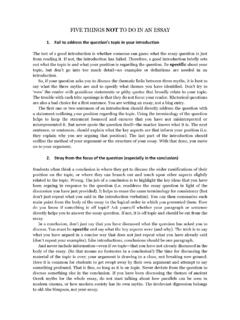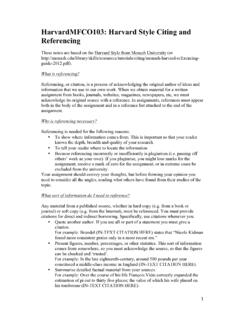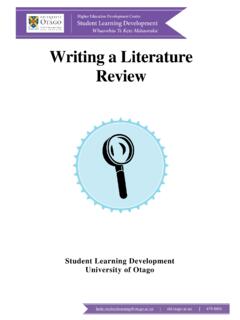Transcription of Alcohol use in adolescence - University of Otago
1 Chapter 19: Alcohol Use in adolescence Chapter 19. Alcohol use in adolescence David Fergusson Christchurch Health and Development Study, University of Otago , Christchurch Joseph Boden Christchurch Health and Development Study, University of Otago , Christchurch Summary There is consistent evidence to suggest that a substantial fraction of New Zealand young people engage in heavy drinking including hazardous drinking, Alcohol abuse and Alcohol dependence. Over a third of young people engage in binge drinking or hazardous drinking and by the age of 25 over 20% will have developed a significant Alcohol related problem. The misuse of Alcohol by young people has been associated with increased risks of a number of adverse outcomes including: motor vehicle collisions, injuries and deaths;. crime; violence; sexual risk taking; mental health problems and victimisation. There is increasing international evidence on the types of policies that are effective in reducing the risks of Alcohol related problems in young people.
2 Effective policies include: increased Alcohol taxation; regulating the availability of Alcohol ; regulation of drink driving; Alcohol marketing restrictions; development of effective treatment services. Approaches having little or no effectiveness include: Alcohol and drug education in schools; public service advertisements advocating responsible drinking and avoidance of drink driving; warning labels on Alcohol containers. The recent Law Commission report provides a comprehensive and evidence-based framework for reforming the supply and regulation of Alcohol in New Zealand. Key reforms that are likely to benefit young people include: increasing the cost of Alcohol ; raising the drinking age and the age at which Alcohol may be purchased to 21. years; adopting a zero tolerance policy for drink driving by under 21 year olds; further restriction on the advertising of Alcohol ; greater regulation of hours of sale, number of outlets and supply of Alcohol in licensed premises frequented by young people; greater investment in treatment for young people with significant Alcohol related problems.
3 Greater investment is required in evaluation research to ascertain the extent to which policy changes have beneficial effects in reducing the misuse of Alcohol by young people. 217. Chapter 19: Alcohol Use in adolescence 1. Introduction The purpose of this chapter is to examine the use and misuse of Alcohol by young people;. to describe the harms associated with Alcohol misuse and to outline policy options for both regulating the use of Alcohol and reducing Alcohol related harms. 2. What is the question? Alcohol is widely used and misused by young New Zealanders with estimates suggesting that over 1 in 3 young people aged 12-16 engage in binge drinking [1] with a similar fraction of young people aged 16-21 engaging in hazardous drinking [2]. There have been ongoing public concerns expressed about young people and Alcohol in both the New Zealand media and in official reports. The growing statistical evidence and public concerns raise three important questions about Alcohol and young people.
4 The first question concerns the extent to which Alcohol use has harmful consequences for young people. The second question concerns the best ways of regulating the purchase, supply and consumption of Alcohol by young people to minimise Alcohol related harms. The third question concerns the development of prevention, treatment and related services aimed at both reducing heavy drinking by young people and providing treatment for young people with Alcohol related problems. 3. Why is Alcohol use important in the transition to adolescence ? There is growing and internationally consistent evidence to suggest that the heavy use of Alcohol by young people makes substantial contributions to risks of a range of adverse conditions in adolescence . Amongst the adverse effects that have been documented are the following. Increased risks of motor vehicle collisions, injuries and deaths The transition to adolescence includes two rites of passage that have consequences of increasing the risks of injury and mortality from motor vehicles.
5 First, over the period of adolescence the majority of young people begin to use Alcohol as part of social activities. For example, estimates from the Christchurch Health and Development study suggest that by the age of 15 over 70% of young people reported drinking within the last year with 30%. reporting drinking at least once per month [3]. Second, the onset of drinking behaviours coincides with age at which a driving licence can be obtained with 15 being the age for acquiring a learner's licence. The combination of these two events places adolescents at risk of drink driving with the attendant harms of motor vehicle collisions, injury and death [4-7]. Increased risks of crime There is now substantial evidence to suggest that the disinhibiting effects of Alcohol place teenagers at increased risks of a range of crimes including: violence; vandalism; sexual crimes; partner violence and property crimes [8-29]. This scientific evidence has been supplemented by growing amounts of video material of public areas that has documented the ways in which the misuse of Alcohol fuels antisocial behaviours by young people [30].
6 218. Chapter 19: Alcohol Use in adolescence Increased risks of sexual risk taking The heavy use of Alcohol is also associated with increased risks of sexual risk taking including multiple sexual partnerships and unprotected sex [31-33]. In turn this increased rate of sexual risk taking is associated with increases in sexually transmitted diseases, pregnancy and abortion [32-35]. Mental health problems and suicidal behaviours There is increasing evidence to implicate the misuse of Alcohol in the development of mental disorders such as depression [3, 36-44] and the development of suicidal behaviours in young people [13, 45-47]. Victimisation The social context within which Alcohol is consumed means that not only are young drinkers at risk of behaving in at risk ways, they are also at increased risk of becoming the victims of drink driving and Alcohol fuelled crimes [19, 29, 48-52]. In reviewing the risks associated with teenage drinking in New Zealand the recent Law Commission's report [53, 54] concludes: One of the greatest challenges we face around Alcohol is how to reconcile the new evidence of the risks Alcohol presents to young people with our cultural norms.
7 Drinking to intoxication is commonly seen in our society as a rite of passage and drinking to intoxication is not only socially accepted but expected. New research has shown that young people experience more harm per standard drink than older drinkers. The highest risk is for those under 15 years but there is still an elevated risk of harm per drink for young people up to the age of 25 years. (p. 83) [53]. In addition, the Law Commission notes: It is hard to think of any other lawful product available in our society that contributes to so many social ills. While Alcohol misuse is only one of several risk factors contributing to these harms, Alcohol distinguishes itself because, like many other factors associated with crime, injury and social dysfunction, the harmful use of Alcohol is a modifiable risk factor. (p. 7) [54]. 4. What is the scale of the problem? A number of New Zealand publications have sought to estimate the fraction of young people who are at risk because of the heavy consumption of Alcohol [1, 2, 18, 53-59].
8 However, different studies have used some different approaches. In studies of younger teenagers, rates of binge drinking have been used to assess the size of Alcohol related problems. For example the Youth 2007 survey reports 34% of young people age 12 to 17 engaged in binge drinking in the last month where binge drinking was defined as drinking more than 5 alcoholic drinks in four hours [1]. The New Zealand Mental Health Survey (Te Rau Hinengaro) reported a range of measures applied to 16 to 24 year olds [2, 55]. These measures include assessment of the number of young people engaging in hazardous drinking as well as those meeting formal diagnostic criteria for Alcohol abuse and dependence. Te Rau Hinengaro found that 79% of young people aged 16-24 drank in the previous 12 months and 49% of those drinkers drank hazardously in that period. The same study showed that, regardless of drinking status, nearly 17% had ever met DSM IV. criteria for Alcohol abuse with having met criteria for Alcohol dependence.
9 These 219. Chapter 19: Alcohol Use in adolescence figures clearly suggest that over a third of young New Zealanders are at risk of Alcohol related problems each year because of their binge drinking and/or hazardous drinking. The percentage who will have met formal diagnostic criteria for an Alcohol related disorder by the time they are 25 years of age will be well over 20%. All of these figures are indicative of a large and growing problem with the misuse of Alcohol by young people [53, 54]. Given the consequences of the misuse of Alcohol by young people for a wide range of outcomes, finding constructive ways of means of regulating the use of Alcohol by young people and mitigating the adverse effects of Alcohol misuse is a matter of high priority in the area of adolescent policy . 5. What does research tell us about causative factors? There has been extensive research into the factors associated with the use and misuse of Alcohol by young people. These factors include the following.
10 Genetic factors There has been growing evidence from both twin studies and behavioural genetic research to suggest genetic factors may play an important role in determining individual susceptibility to Alcohol abuse and dependence [60-65]. Estimates suggest that up to 60%. of the variation in Alcohol abuse and dependence may be accounted for by genetic factors [66]. It is likely that genetic factors interact with environmental influences so that those most at risk of Alcohol related problems are both genetically susceptible to these problems and are exposed to social environments that encourage the misuse of Alcohol [67]. Socio-demographic factors There is extensive evidence which suggests higher rates of Alcohol misuse amongst certain groups within the population. Males are more likely to misuse Alcohol than females although recent evidence suggests that the gender gap in this area is reducing amongst young people [68-72]. Young people from socially disadvantaged background characterised by low family income and socio-economic status are at greater risk [73, 74].
